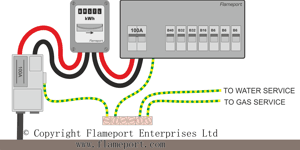Supply Types
Identifiying the type of supply is essential, as the selection of consumer unit and protective devices will partially or fully depend on the type of supply.
Note that while the examples here are the most common arrangements, there are variations. If in doubt, contact the DNO (Distribution Network Operator) for your area to confirm the supply type.
In this section
Identification of Parts
The Cutout
The Meter
Other equipment
TNS supply
TNCS supply
TT supply
UK Electricity Supply Example - Who Owns What
Other supply types
Supply Types Video
Identification of Parts
 This diagram shows a typical TNCS supply. The supply cable enters the property (underground in this example) and is connected into the cutout. This contains a fuse for the live conductor, and terminals for the neutral and earth.
This diagram shows a typical TNCS supply. The supply cable enters the property (underground in this example) and is connected into the cutout. This contains a fuse for the live conductor, and terminals for the neutral and earth.
Removing the fuse disconnects the supply to the property. Some people may also refer to the cutout as the 'head' or 'supply head'. Either way, it belongs to the DNO, and they are the only ones who should be removing the fuse.
From the cutout, a single core live and neutral go to the electricity meter. Another single core green/yellow wire connects to the main earthing terminal, or MET. Here, the MET is a separate terminal block, although it can be located inside the fusebox or consumer unit.
From the meter, another pair of single core wires ('tails') connect to the customer's consumer unit. These tails denote the start of the customer's installation - eveything before and including the meter belong to the DNO. The cutout and meter will be sealed.
The other green and yellow stripe wires connect from the MET to metallic service pipes, most commonly gas and water. These are the main equipotential bonds, and are there to ensure that in the event of a fault, all of the exposed metalwork in the property remains at the same potential, reducing the risk of electric shock.
The Cutout
These come in a variety of styles, modern ones being plastic. Older ones were filled with pitch (a black tar substance) for insulation. Normally solid, but when heated, this will flow and drip out of the cutout. If you see this, call your electricity supplier so they can arrange for the cutout to be replaced.
Very old cutouts were cast iron with ceramic fuses inside. These are well past their expected lifespan and should also be replaced. Some of these may contain a fuse for the neutral - this is dangerous and is another reason to have the cutout replaced.
Red coloured cutouts are sometimes used in blocks of flats or converted properties. These have no fuse, just a removeable solid link. Another cutout with a fuse will be located elsewhere, such as in a main switchroom or basement.
The Meter
Two main types - the credit meter, which just shows the reading on dials or digits, and the pre-pay meter which requires and electronic rechargeable key to be inserted. (Older types used coins or tokens).
Pre-pay meters are common in rented properties, or where the occupants 'forgot' to pay the electricity bill. These are inconvenient, as the keys have to be recharged at a local shop, and expensive, as the rate charged is more than for a credit meter.
A photograph of an electricity meter and cutout can be seen in the old equipment section.
Other equipment
Various other items may be found, for example:
- Dual rate meters (for Economy 7 or other dual rate tariffs)
- Timeclocks or teleswitches (also for E7)
- Separate isolator switch (between the meter and the consumer unit)
- Connection blocks ('Henley' blocks) where more than one consumer unit is fitted
- Switchfuses (where the consumer unit is located some distance from the meter)


